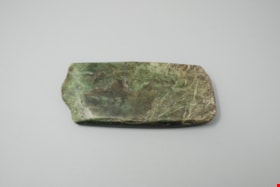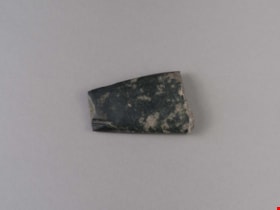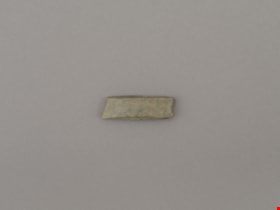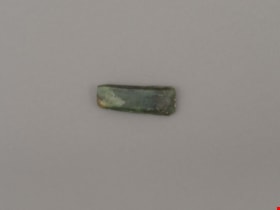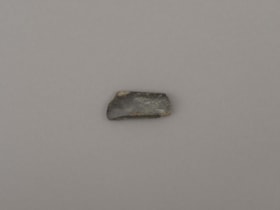More like 'Students in Chromos Molecular Systems lab'
Narrow Results By
Subject
- Agriculture 1
- Agriculture - Farms 2
- Archeological Specimen 33
- Armament 18
- Arts 1
- Buildings - Commercial - Grocery Stores 1
- Buildings - Commercial - Restaurants 3
- Buildings - Commercial - Service Stations 1
- Buildings - Industrial - Saw Mills 1
- Buildings - Religious - Monasteries 1
- Buildings - Religious - Mosques 1
- Businesses 1
Person / Organization
- Alpha Secondary School 1
- Arora, Maninder 1
- Babey, Beverley 1
- Binning, Dr. Sadhu 1
- Binning, Gurmaje Kaur 1
- Binning, Jagdish 1
- Binning, Jit Singh 1
- Brentwood Park School 1
- Brentwood Shopping Centre 1
- British Columbia Hydro and Power Authority 1
- British Columbia Organization to Fight Racism 1
- Burnaby Central Secondary School 1
hand maul
https://search.heritageburnaby.ca/link/museumartifact3392
- Repository
- Burnaby Village Museum
- Accession Code
- BV988.6.1
- Description
- Flat topped stone maul.
- Subjects
- Persons
- Indigenous peoples - British Columbia
- Woodworking Tools and Equipment
- Woodworking Tools and Equipment - Maul
Images
Documents
hand maul
https://search.heritageburnaby.ca/link/museumartifact3393
- Repository
- Burnaby Village Museum
- Accession Code
- BV988.6.2
- Description
- Flat topped stone maul, broken
- Subjects
- Persons
- Indigenous peoples - British Columbia
- Woodworking Tools and Equipment
- Woodworking Tools and Equipment - Maul
Images
Documents
hand maul
https://search.heritageburnaby.ca/link/museumartifact15555
- Repository
- Burnaby Village Museum
- Accession Code
- HV983.32.13
- Description
- Nipple topped stone maul. Nipple topped stone maul. It has a crack through the entire shaft and the two halves look of different colour and stone type. There is a large chip missing along the crack.
- Object History
- The donor was of European decent and was given this maul by an unidentified person. In general, hand mauls are used in woodworking todrive antler wedges or spreading sticks into logs and split planks. They were also used in combination with chisels for detail work. Their presence at an archeological site is viewed as evidence of long term habitations. They are associated with house building, canoe building, housepost and welcome figure carving. Nipple top hand mauls are identified as Marpole Culture (400 BC - 400 AD).
- Country Made
- Canada
- Province Made
- British Columbia
- Culture
- First Nations
- Subjects
- Persons
- Indigenous peoples - British Columbia
- Woodworking Tools and Equipment
- Woodworking Tools and Equipment - Maul
Images
Documents
hand maul
https://search.heritageburnaby.ca/link/museumartifact34041
- Repository
- Burnaby Village Museum
- Accession Code
- BV991.26.1
- Description
- Conical topped stone maul; damaged area on one side; broken area at bottom edge.
- Object History
- Maul was found in the late 1920s by Joseph Theodore Dorman on his property on Cliff Avenue, between Halifax and Broadway. In general, hand mauls are used in woodworking todrive antler wedges or spreading sticks into logs and split planks. They were also used in combination with chisels for detail work. Their presence at an archeological site is viewed as evidence of long term habitations. They are associated with house building, canoe building, housepost and welcome figure carving. Nipple top hand mauls are identified as Marpole Culture (400 BC - 400 AD).
- Country Made
- Canada
- Province Made
- British Columbia
- Subjects
- Persons
- Indigenous peoples - British Columbia
- Woodworking Tools and Equipment
- Woodworking Tools and Equipment - Maul
Images
Documents
hand maul
https://search.heritageburnaby.ca/link/museumartifact34042
- Repository
- Burnaby Village Museum
- Accession Code
- BV991.26.2
- Description
- Nipple topped stone maul. There is a damaged area on one side and the bottom edge is badly chipped. There are blackish oily stains on the side of the maul.
- Object History
- Was found in the late 1920s by Joseph Theodore Dorman on his property on Cliff Avenue, between Halifax and Broadway.
- Country Made
- Canada
- Province Made
- British Columbia
- Culture
- First Nations
- Subjects
- Persons
- Indigenous peoples - British Columbia
- Woodworking Tools and Equipment
- Woodworking Tools and Equipment - Maul
Images
Documents
hand maul
https://search.heritageburnaby.ca/link/museumartifact44533
- Repository
- Burnaby Village Museum
- Accession Code
- BV002.37.6
- Description
- Hand maul, stone; fragment, no top.
- Object History
- Donor's father found the maul in 1946-1947 when excavating a lot at 4203 Norfolk Street. The lot was kitty corner to Schou Street School.
- Subjects
- Persons
- Indigenous peoples - British Columbia
- Woodworking Tools and Equipment
- Woodworking Tools and Equipment - Maul
- Archeological Specimen
- Geographic Access
- Norfolk Street
Images
Documents
hand maul
https://search.heritageburnaby.ca/link/museumartifact44853
- Repository
- Burnaby Village Museum
- Accession Code
- BV002.57.1
- Description
- Nipple topped stone maul. It has a pointed tip and a slight indentation on side of base. There is adhesive residue on bottom of base.
- Object History
- The donor inherited this artifact from his mother, Katherine Maude (Kitty) Peers, who inherited them from her father, Louis Claude Hill. The artifacts were found on his farm, Brookfield Farm, at Douglas Road and Sperling Avenue (now site of Burnaby Village Museum). In general, hand mauls are used in woodworking todrive antler wedges or spreading sticks into logs and split planks. They were also used in combination with chisels for detail work. Their presence at an archeological site is viewed as evidence of long term habitations. They are associated with house building, canoe building, housepost and welcome figure carving. Nipple top hand mauls are identified as Marpole Culture (400 BC - 400 AD).
- Subjects
- Persons
- Indigenous peoples - British Columbia
- Woodworking Tools and Equipment
- Woodworking Tools and Equipment - Maul
- Archeological Specimen
- Historic Neighbourhood
- Burnaby Lake (Historic Neighbourhood)
Images
Documents
hand maul
https://search.heritageburnaby.ca/link/museumartifact44854
- Repository
- Burnaby Village Museum
- Accession Code
- BV002.57.2
- Description
- Conical topped stone maul; damaged by a plow.
- Object History
- The donor inherited this artifact from his mother, Katherine Maude (Kitty) Peers, who inherited them from her father, Louis Claude Hill. The artifacts were found on his farm, Brookfield Farm, at Douglas Road and Sperling Avenue (now site of Burnaby Village Museum).
- In general, hand mauls are used in woodworking todrive antler wedges or spreading sticks into logs and split planks. They were also used in combination with chisels for detail work. Their presence at an archeological site is viewed as evidence of long term habitations. They are associated with house building, canoe building, housepost and welcome figure carving. Flat and conical topped hand mauls are identified as Gulf of Georgia Culture (400 AD - 1800).
- Subjects
- Persons
- Indigenous peoples - British Columbia
- Woodworking Tools and Equipment
- Woodworking Tools and Equipment - Maul
- Archeological Specimen
- Historic Neighbourhood
- Burnaby Lake (Historic Neighbourhood)
Images
Documents
chisel
https://search.heritageburnaby.ca/link/museumartifact38885
- Repository
- Burnaby Village Museum
- Accession Code
- BV998.11.1
- Description
- Chisel shaped tool, wedge-shaped; mainly green with white and brown fissures throughout. One side has elevated edge, possibly for attaching to handle.
- Object History
- The stone chisel was found by Archie Card, ca 1930 in the yard of the Card family home at 329 Richmond Street (later renamed Elwell) in Burnaby.
Images
Documents
Mountain Goat Horn Spoon
https://search.heritageburnaby.ca/link/museumartifact30018
- Repository
- Burnaby Village Museum
- Accession Code
- HV973.73.177
- Description
- Horn spoon with fine carving on the narrow handle. Material is very dark.
- Object History
- Along the Northwest Coast, in general, undecorated spoons of wood and horn were used in everyday life, while more elaborately carved versions were used on special occasions. Horn spoons were often passed down in families as heirlooms, such spoons are generally darker in colour than those of recent manufacture. The bowls of these spoons are too large to place in the mouth, so food is sipped from the sides or the end.
- The bowl of the mountain goat horn spoon is made from the larger part of the horn, at the base. The handle is made from the tip. It is straightened out by steaming in a wooden mould and then scored out inside as part of the shaping process
- Country Made
- Canada
- Province Made
- British Columbia
- School/Style
- Coast Salish
- Culture
- Haida
Images
Documents
weight
https://search.heritageburnaby.ca/link/museumartifact44855
- Repository
- Burnaby Village Museum
- Accession Code
- BV002.57.3
- Description
- Net weight, round, stone, doughnut-shaped with hole in the middle.
- Object History
- The donor inherited this artifact from his mother, Katherine Maude (Kitty) Peers, who inherited them from her father, Louis Claude Hill. The artifacts were found on his farm, Brookfield Farm, at Douglas Road and Sperling Avenue (now site of Burnaby Village Museum).
- Subjects
- Persons
- Indigenous peoples - British Columbia
- Weights and Measurements Tools and Equipment
- Archeological Specimen
- Historic Neighbourhood
- Burnaby Lake (Historic Neighbourhood)
Images
Documents
weight
https://search.heritageburnaby.ca/link/museumartifact44856
- Repository
- Burnaby Village Museum
- Accession Code
- BV002.57.4
- Description
- Net weight, round, stone, doughnut-shaped with hole in the middle. Made of volcanic stone.
- Object History
- The donor inherited this artifact from his mother, Katherine Maude (Kitty) Peers, who inherited them from her father, Louis Claude Hill. The artifacts were found on his farm, Brookfield Farm, at Douglas Road and Sperling Avenue (now site of Burnaby Village Museum).
- Subjects
- Persons
- Indigenous peoples - British Columbia
- Weights and Measurements Tools and Equipment
- Archeological Specimen
- Historic Neighbourhood
- Burnaby Lake (Historic Neighbourhood)
Images
Documents
booklet
https://search.heritageburnaby.ca/link/museumartifact17357
- Repository
- Burnaby Village Museum
- Accession Code
- HV979.42.7
- Description
- Museum & Art Notes - Booklet -- [1949]. The Art Historical and Scientific Association publication of Museum & Art Notes. This is Volume 1, Number 1 of the Second Series, September 1949. The front cover features a picture of the Dimorphodon Macronyx model made by Madam Erna C. von Engel-Baiersdorf. This issue has articles on: The Method of Reconstructiong Human and Animal Remains in Sculpture and in Paintings Early History of the Burnaby Family Indian Native Art Sundews The Aleuts of Attu The Trumpeter Swan Achatina Fulica, The Great African Snail Some Field Work of the Curator Palomar's Giant Eye, the Hale Telescope The Directors, Life and Honorary Members of the Art, Historical and Scientific Association.
- Subjects
- Documentary Artifacts
- Documentary Artifacts - Booklets
- Organizations
- Organizations - Art Societies
- Organizations - Historical Societies
- Organizations - Science Societies
Images
Documents
Interview with Ellen and Bill Schwartz
https://search.heritageburnaby.ca/link/museumdescription19602
- Repository
- Burnaby Village Museum
- Date
- [1969-2023] (interview content), interviewed 15 May 2023
- Collection/Fonds
- Burnaby Village Museum fonds
- Description Level
- Item
- Physical Description
- 2 sound recordings (wav) (68 min., 52 sec.) + 1 sound recording (mp3) (68 min., 53 sec.)
- Scope and Content
- Item consists of a recording of an oral history interview with Ellen and Bill Schwartz conducted by Burnaby Village Museum Registrar and Researcher, Eric Damer. 00:00-16:47 Bill and Ellen share where they were born, grew up and went to school as citizens of the United States and how they met in Pe…
- Repository
- Burnaby Village Museum
- Collection/Fonds
- Burnaby Village Museum fonds
- Series
- Museum Oral Histories series
- Subseries
- Many Voices Project Interviews subseries
- Description Level
- Item
- Physical Description
- 2 sound recordings (wav) (68 min., 52 sec.) + 1 sound recording (mp3) (68 min., 53 sec.)
- Material Details
- Interviewer: Eric Damer Interviewees: Ellen and Bill Schwartz Location of Interview: Burnaby Village Museum Interview Date: May 15, 2023 Total Number of tracks: 2 Total Length of all Tracks: 01:08:52 Digital master recordings (wav) were recorded onto two separate audio tracks, edited and merged together and converted to mp3 for access on Heritage Burnaby Photograph information: Bill and Ellen Schwartz.
- Scope and Content
- Item consists of a recording of an oral history interview with Ellen and Bill Schwartz conducted by Burnaby Village Museum Registrar and Researcher, Eric Damer. 00:00-16:47 Bill and Ellen share where they were born, grew up and went to school as citizens of the United States and how they met in Pennsylvania the 1970s. Bill and Ellen explain how in the 1970s, they were discouraged about the current politics in the United States under the Nixon administration and how they were inspired by the “back to the land” ideals, rejecting materialism and wanting an alternative lifestyle. With these ideals in mind, they recall how in 1972 they and a few other friends decided to leave the United States, move to British Columbia with the goal of buying land in the Okanagan or Kootenay region and starting a new lifestyle for themselves. Bill and Ellen recollect how they purchased 20 acres of land in Galena Bay in the Kootenays and how they lived in the area off and on until the early 1980s. They describe how they cleared three acres of land, built a cabin, put in a garden, chicken coop and honey bees. With the challenges of the isolated location and no access to electricity they explain how they decided that they had to live elsewhere in order to make a living. Ellen talks about working as a special education teacher in Revelstoke and Slocan and how Bill obtained his teaching certificate while they lived in Nelson. Bill and Ellen describe themselves as environmentalists and of how they both became active Provincial environmentalists during the construction of the Revelstoke Dam. Bill talks about getting work with the “Energy Van” program talking about energy conservation, renewable energy and recycling. They explain how after their first child was born in 1980, they returned to Galena Bay for about a year and a half until Bill was offered a job with the Department of Energy Conservation which lead them to move to Vancouver. 16:48 – 22:46 Bill and Ellen describe their first few years of living in Vancouver and at University of British Columbia while Ellen completed her master’s degree in creative writing. During this time, they had their second child. They recall how in 1988 how they purchased a house in Burnaby, selecting to live in the Deer Lake neighbourhood. They talk about the benefits of the neighbourhood including; a French immersion school for their children, proximity to the trails around Deer Lake and having transit close by. 22:47 – 33:55 Bill and Ellen talk about their consulting business “Polestar Communications”. A Burnaby based communications consulting firm composed of three people, Ellen and Bill and colleague Richard Banner. They describe how their business got started and some of the projects that they’ve worked on including; BC Hydro’s Power Smart Program, financial literacy curriculum that was introduced in B.C. schools and reports for the Province of British Columbia. Ellen and Bill convey how Bill has been a very active member with the City of Burnaby Environment Committee, the Steering Committee to develop a sustainable environmental strategy for Burnaby, how he’s been awarded for his contributions in coaching youth sports and other areas in which they have both volunteered. 33:56 – 43:07 Ellen describes how she got started in writing educational resources about the environment and how since she completed grad school in 1984, she’s published nineteen books. Ellen conveys how her first book was published and sold to the Province of British Columbia as part of the B.C. educational curriculum on the environment. Ellen talks about some of the children’s books that she’s written and published with themes including; social justice, the labour movement and racism in sports. Ellen describes some of her books and the research that she’s done. 43:08 – 51:04 Ellen and Bill Schwartz reflect on what they like about living in Burnaby. They talk about the benefits of their neighbourhood including; performances at the Shadbolt Centre for the Arts, the Burnaby Blues and Roots Festival, the Burnaby Art Gallery and Deer Lake as well as having access to parks and community centres in Burnaby. 51:05-56:36 Bill and Ellen reflect on their involvement in the Jewish community, considering themselves non-secular Jews. Ellen talks about how they were involved with “Burquest” a Jewish Community Association and how they often observe some of the Jewish holidays including Hanukah and traditions including the Jewish coming of age ritual, bar mitzvah (masc.) and bat mistvah (fem.). Ellen mentions her involvement with the “Jone Betty Stuchner Oy Vey! Funniest Children’s book Award” where she acts a judge and her involvement with the Jewish Book festival and that she is a recipient of the Jewish Book award. 56:37 – 1:08:53 Bill and Ellen reflect on their 35 years living in Burnaby and how they’ve seen it change. They talk about the increased development and density in the city, how they are troubled by a lack of low income housing, the benefits and importance of public transportation and preservation of green space including Burnaby parks.
- History
- Interviewees' biographies: Ellen Schwartz was born in Washington, DC, (1950) but grew up in New Jersey. She attended the Universities of Chicago and Wisconsin before moving to a farm in Pennsylvania, where she met her future husband Bill Schwartz. Bill Schwartz grew up in and around Philadelphia (b. 1947), and attended Pennsylvania State University. After travelling, and discouraged with life in eastern America, he and Ellen decided that British Columbia held better prospects. Bill and Ellen quit their jobs in 1972 and moved to the Kootenay region where they adopted a “back to the land” lifestyle, a very new experience for both of them. After eight years of modest success, and occasional work in nearby towns, they opted to return to Vancouver where Bill had work and where they could raise a family more easily. They rented in Vancouver for a few years before moving to family housing at UBC, while Ellen studied creative writing. Bill founded a communications and writing company, and in 1988 they purchased a home in Burnaby. Ellen launched a new career as a writer, mainly for children young adults. Both were active in their careers, raising a family, and participating in local social and political activities. Interviewer biography: Eric Damer is a Burnaby Village Museum Interpreter, Museum Registrar, Researcher and Blacksmith. Eric pounded hot steel for the first time in 1977 in junior high. Fifteen years later, he joined Burnaby Village Museum where he has smithed for three decades. He also provides historical research for museum exhibits and special projects. Outside the museum, Eric is a social historian with a special interest in educational history.
- Creator
- Burnaby Village Museum
- Subjects
- Education
- Environmental Issues
- Environmental Issues - Environmental Protection
- Geographic Features
- Geographic Features - Parks
- Housing
- Occupations
- Occupations - Entrepreneurs
- Occupations - Writers
- Persons - Volunteers
- Persons - Jewish Canadians
- Social Issues
- Social Issues - Racism
- Religions
- Religions - Judaism
- Names
- Schwartz, William "Bill"
- Schwartz, Ellen
- City of Burnaby
- Polestar Communications
- British Columbia Hydro and Power Authority
- Responsibility
- Damer, Eric
- Accession Code
- BV023.16.6
- Access Restriction
- No restrictions
- Reproduction Restriction
- No known restrictions
- Date
- [1969-2023] (interview content), interviewed 15 May 2023
- Media Type
- Sound Recording
- Historic Neighbourhood
- Burnaby Lake (Historic Neighbourhood)
- Planning Study Area
- Burnaby Lake Area
- Notes
- Title based on contents of item
- Transcription available on Heritage Burnaby
Images
Documents
Audio Tracks
Interview with Ellen and Bill Schwartz, [1969-2023] (interview content), interviewed 15 May 2023
Interview with Ellen and Bill Schwartz, [1969-2023] (interview content), interviewed 15 May 2023
https://search.heritageburnaby.ca/media/hpo/_Data/_BVM_Sound_Recordings/Oral_Histories/2023_0016_0006_003.mp3Interview with Jagandeep "Jag" Nagra
https://search.heritageburnaby.ca/link/museumdescription19605
- Repository
- Burnaby Village Museum
- Date
- 1984-2023 (interview content), interviewed 5 Jun. 2023
- Collection/Fonds
- Burnaby Village Museum fonds
- Description Level
- Item
- Physical Description
- 1 sound recording (wav) (47 min., 26 sec.) + 1 sound recording (mp3) (47 min., 27 sec.)
- Scope and Content
- Item consists of a recording of an oral history interview with Jagandeep "Jag" Nagra interviewed by Burnaby Village Museum Registrar, James Binks. 00:00:00 – 00:04:31 The interview opens with introductions and biographical details about Jag Nagra. The interviewer shares information about Jag Nagra…
- Repository
- Burnaby Village Museum
- Collection/Fonds
- Burnaby Village Museum fonds
- Series
- Museum Oral Histories series
- Subseries
- Many Voices Project Interviews subseries
- Description Level
- Item
- Physical Description
- 1 sound recording (wav) (47 min., 26 sec.) + 1 sound recording (mp3) (47 min., 27 sec.)
- Material Details
- Interviewer: James Binks Interviewee: Jagandeep "Jag" Nagra Location of Interview: Burnaby Village Museum Interview Date: June 5, 2023 Total Number of tracks: 1 Total Length of all Tracks: 47:27
- Scope and Content
- Item consists of a recording of an oral history interview with Jagandeep "Jag" Nagra interviewed by Burnaby Village Museum Registrar, James Binks. 00:00:00 – 00:04:31 The interview opens with introductions and biographical details about Jag Nagra. The interviewer shares information about Jag Nagra’s art career and the many art projects and commissions that Jag has worked on. Jag shares information about her parents, providing details about their immigration to British Columbia from Punjab and the places that Jag and her family have lived over the years. 00:04:32 – 00:12:38 Jag talks about what inspired her to become interested in art, her art education and how her artistic practice and expression have developed over time. Jag describes how she first started in graphic design, how she’s become more involved in public art and her experience working in design. Jag touches on her experiences of being a South Asian growing up and living in a predominantly white neighbourhood and provides information about her parents, Avatar Singh Nagra and Rajwant Kaur Nagra and their migration to Canada. 00:12:39 – 00:20:03 Jag talks about her inspiration in creating her work, her involvement with the revitalization of the Punjabi Market in Vancouver, the Punjabi Market Collective and other public art projects that she’s been involved with focusing on the South Asian community and LGBTQ+ issues. 00:20:04 – 00:41:09 Jag talks about her involvement with the Burnaby Village Museum’s exhibit “Truths Not Often Told: Being South Asian in Burnaby”. The interviewer and Jag take a walk throughout the exhibit while Jag describes the art work that she created for the exhibit and her creative process. Jag reflects on her own experiences being involved in the exhibit. 00:41:10 – 00:47:27 Jag talks about her own experiences as a South Asian Queer artist reflecting on her experiences within the art community. In closing Jag reflects on the impacts of the exhibit that celebrates South Asian culture in Burnaby.
- History
- Interviewee biography: Jagandeep "Jag" Nagra is a queer Panjabi Visual Artist passionate about community development, making art accessible and ending stigma against LGBTQ+ people within the South Asian community. Nagra has worked with clients such as the Vancouver Canucks, Tim Hortons and Microsoft and is currently serving as Vice Chair of the Punjabi Market Collective. She is featured in the internationally acclaimed, award wining LGBTQ documentary Emergence: Out of the Shadows. Her artworks are part of the Museum of Vancouver’s permanent collection and have been commissioned for the Burnaby Village Museum exhibit "Truths Not Often Told: Being South Asian in Burnaby". Interviewer biography: James Binks has lived in the Lower Mainland since 2009 after relocating from Ontario. James holds a Bachelor of Arts in Anthropology from the University of British Columbia, where he conducted researched on heritage, environment, and globalization in India, Nepal, and Italy. At Burnaby Village Museum, James contributed to the exhibit “Truths Not Often Told: Being South Asian in Burnaby”.
- Creator
- Burnaby Village Museum
- Subjects
- Migration
- Persons - South Asian Canadians
- Persons - LGBTQ+
- Occupations - Artists
- Social Issues
- Social Issues - Racism
- Social Issues - Discrimination
- Names
- Nagra, Jagandeep "Jag"
- Responsibility
- Binks, James
- Accession Code
- BV023.16.9
- Access Restriction
- No restrictions
- Reproduction Restriction
- No known restrictions
- Date
- 1984-2023 (interview content), interviewed 5 Jun. 2023
- Media Type
- Sound Recording
- Notes
- Title based on contents of item
- Transcription available on Heritage Burnaby
Documents
Audio Tracks
Interview with Jagandeep
adze blade
https://search.heritageburnaby.ca/link/museumartifact44868
- Repository
- Burnaby Village Museum
- Accession Code
- BV002.57.19
- Description
- Nephrite adze blade; chipped on one end; rectangular shaped.
- Object History
- The donor inherited this artifact from his mother, Katherine Maude (Kitty) Peers, who inherited them from her father, Louis Claude Hill. The artifacts were found on his farm, Brookfield Farm, at Douglas Road and Sperling Avenue (now site of Burnaby Village Museum).
- Nephrite is found in the Fraser Canyon
- Culture Phase: Possibly Locarno Beach phase (3520-2200 Before Present) or Marpole (400BC - 400AD)
- Historic Neighbourhood
- Burnaby Lake (Historic Neighbourhood)
Images
Documents
adze blade
https://search.heritageburnaby.ca/link/museumartifact44870
- Repository
- Burnaby Village Museum
- Accession Code
- BV002.57.21
- Description
- Chisel, adze or axe blade made of serpentine; black; ends broken off; tapered rectangle shape.
- Object History
- The donor inherited this artifact from his mother, Katherine Maude (Kitty) Peers, who inherited them from her father, Louis Claude Hill. The artifacts were found on his farm, Brookfield Farm, at Douglas Road and Sperling Avenue (now site of Burnaby Village Museum).
- Culture Phase: Locarno Beach (3520-2200 Before Present) or Marpole (400BC - 400AD)
- Historic Neighbourhood
- Burnaby Lake (Historic Neighbourhood)
Images
Documents
adze blade
https://search.heritageburnaby.ca/link/museumartifact44872
- Repository
- Burnaby Village Museum
- Accession Code
- BV002.57.23
- Description
- Chisel, adze or axe blade made of serpentine; small
- Object History
- The donor inherited this artifact from his mother, Katherine Maude (Kitty) Peers, who inherited them from her father, Louis Claude Hill. The artifacts were found on his farm, Brookfield Farm, at Douglas Road and Sperling Avenue (now site of Burnaby Village Museum).
- Culture Phase: Locarno Beach (3520-2200 Before Present) or Marpole (400BC - 400AD)
- Historic Neighbourhood
- Burnaby Lake (Historic Neighbourhood)
Images
Documents
adze blade
https://search.heritageburnaby.ca/link/museumartifact44873
- Repository
- Burnaby Village Museum
- Accession Code
- BV002.57.24
- Description
- Nephrite adze blade; small
- Object History
- The donor inherited this artifact from his mother, Katherine Maude (Kitty) Peers, who inherited them from her father, Louis Claude Hill. The artifacts were found on his farm, Brookfield Farm, at Douglas Road and Sperling Avenue (now site of Burnaby Village Museum).
- Nephrite is found in the Fraser Canyon
- Culture Phase: Locarno Beach (3520-2200 Before Present) or Marpole (400BC - 400AD)
- Historic Neighbourhood
- Burnaby Lake (Historic Neighbourhood)
Images
Documents
adze blade
https://search.heritageburnaby.ca/link/museumartifact44874
- Repository
- Burnaby Village Museum
- Accession Code
- BV002.57.25
- Description
- Adze blade; small; possibly nephrite.
- Object History
- The donor inherited this artifact from his mother, Katherine Maude (Kitty) Peers, who inherited them from her father, Louis Claude Hill. The artifacts were found on his farm, Brookfield Farm, at Douglas Road and Sperling Avenue (now site of Burnaby Village Museum).
- Nephrite is found in the Fraser Canyon
- Culture Phase: Locarno Beach (3520-2200 Before Present) or Marpole (400BC - 400AD)
- Historic Neighbourhood
- Burnaby Lake (Historic Neighbourhood)
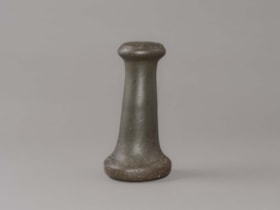
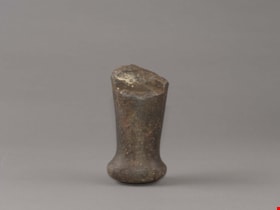
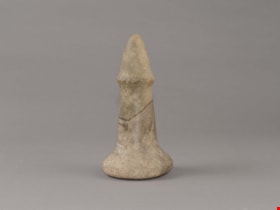
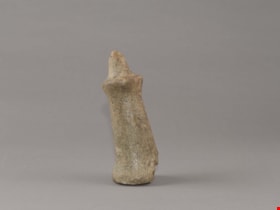
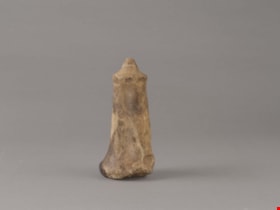
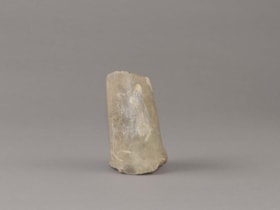
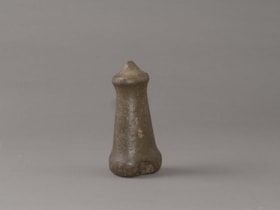
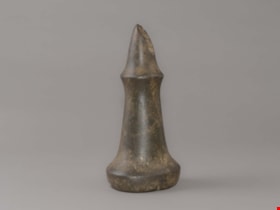
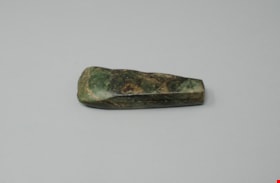
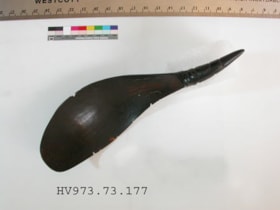
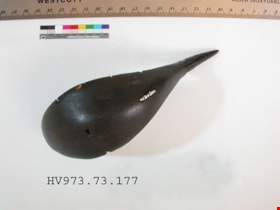
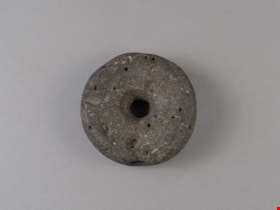
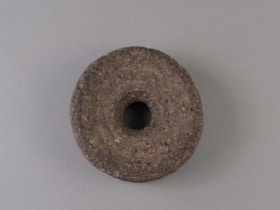
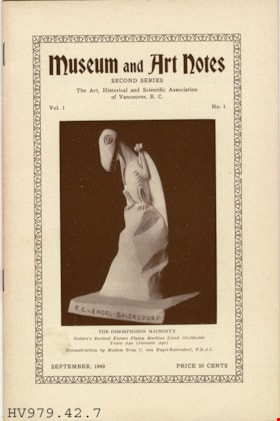
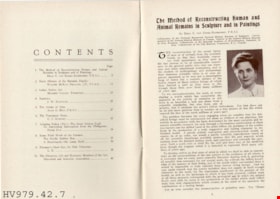
![Interview with Ellen and Bill Schwartz, [1969-2023] (interview content), interviewed 15 May 2023 thumbnail](/media/hpo/_Data/_BVM_Sound_Recordings/Oral_Histories/2023_0016_0006_001.jpg?width=280)
